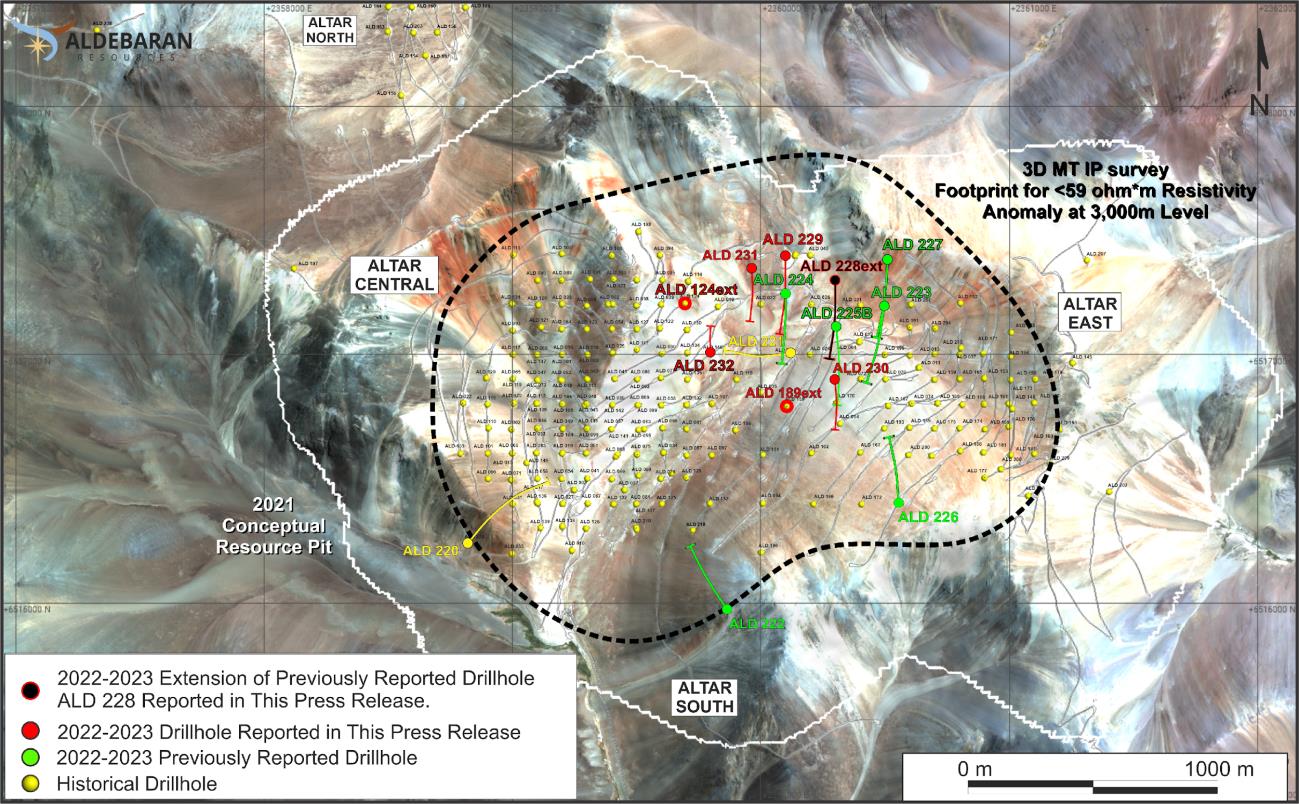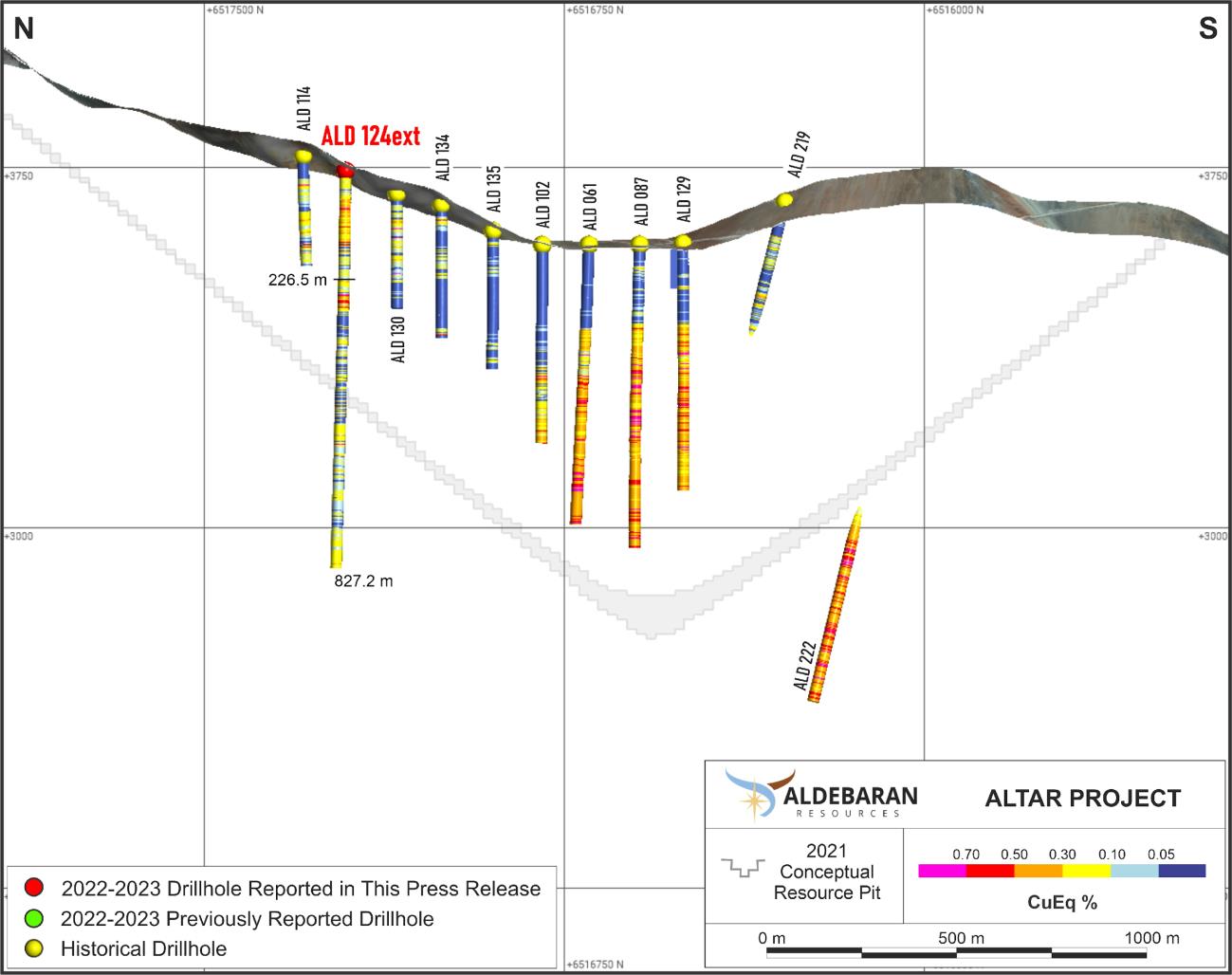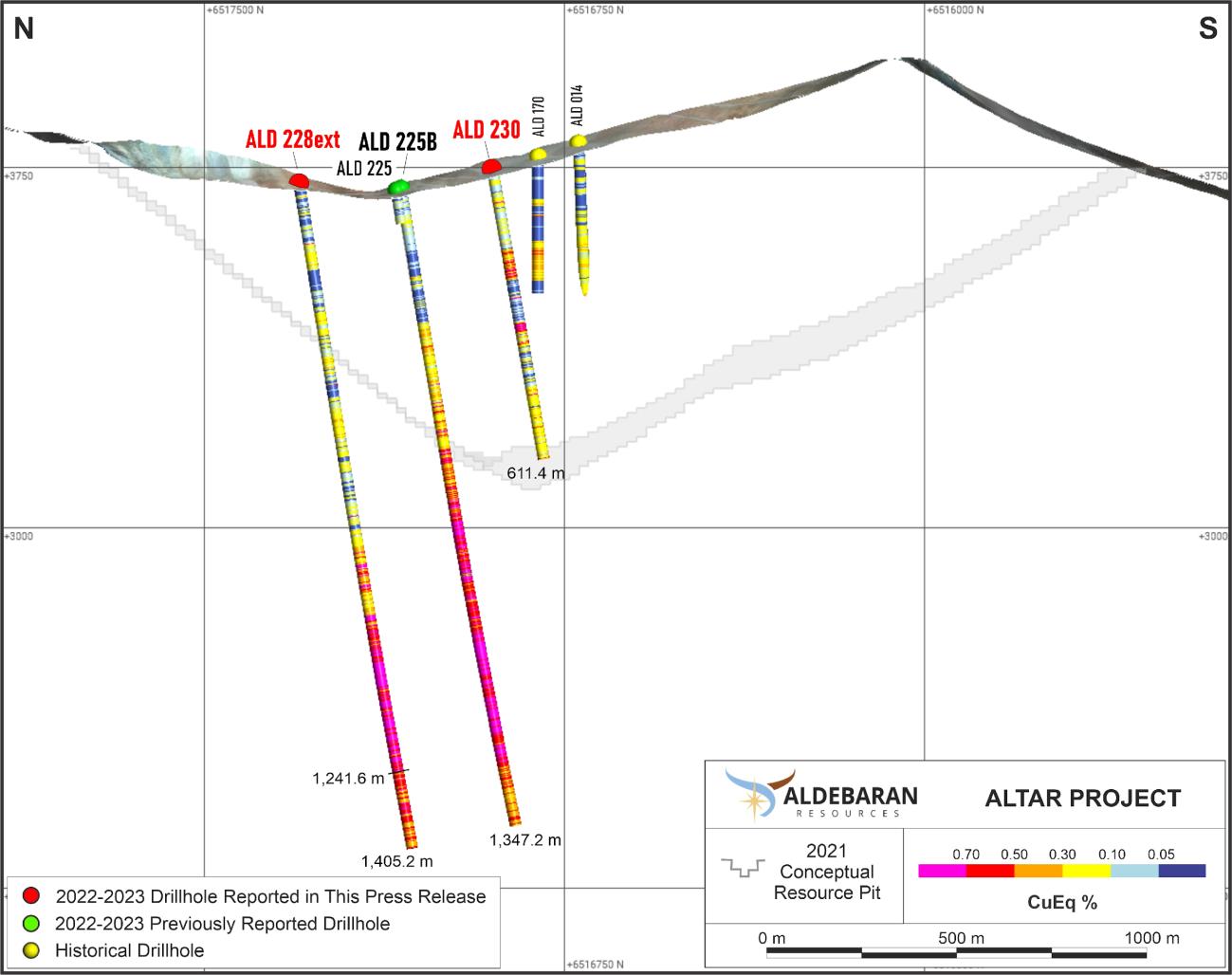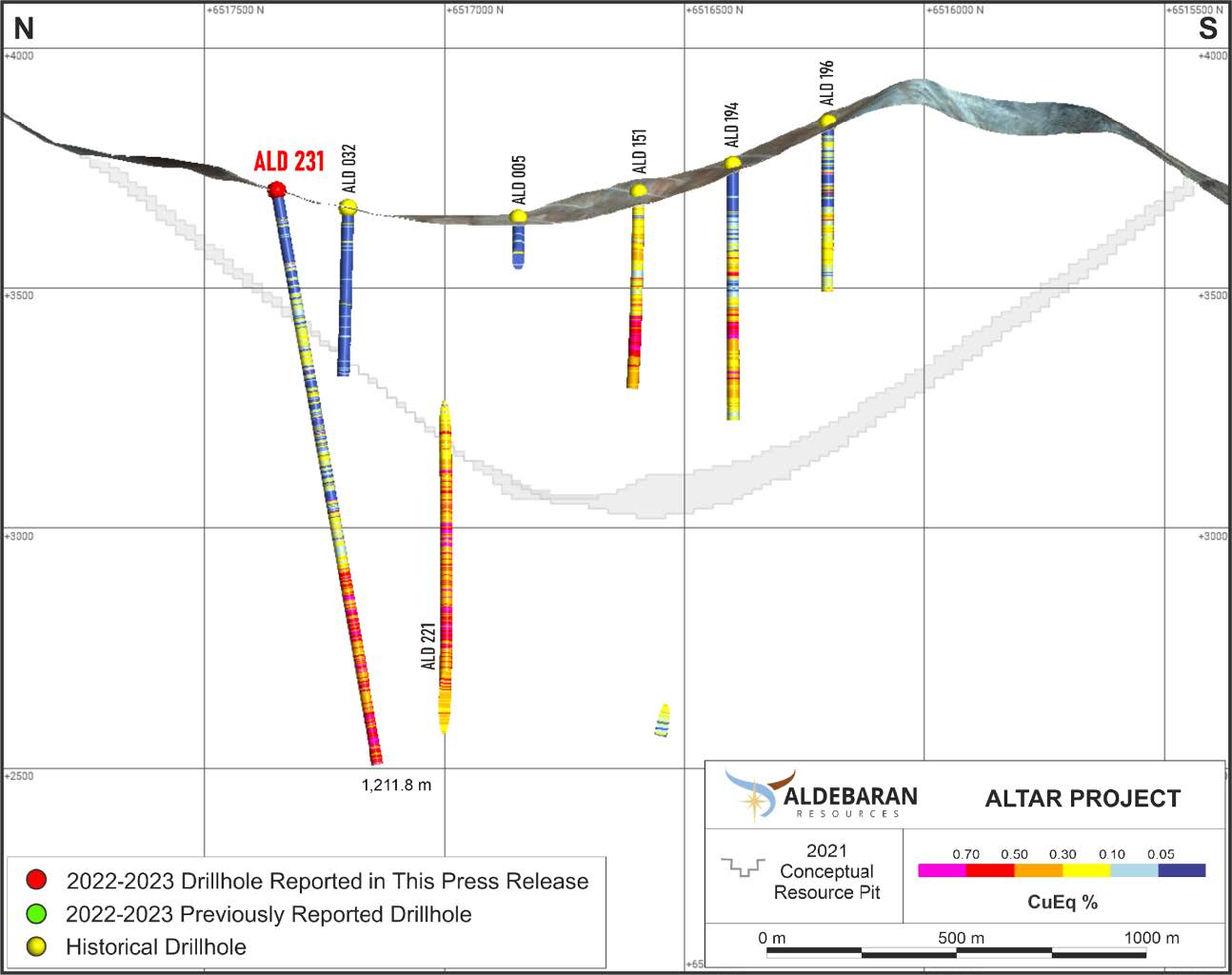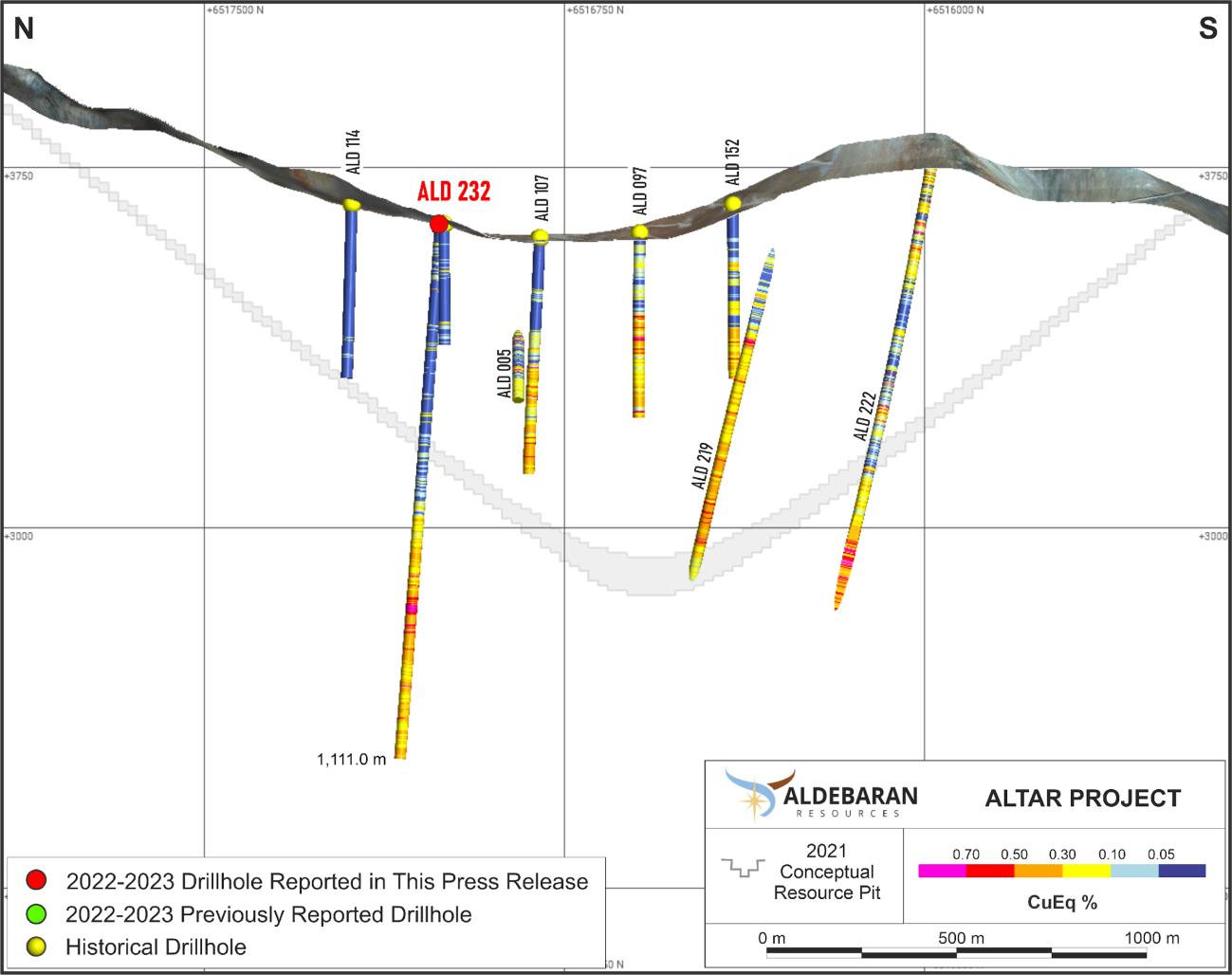VANCOUVER, CANADA (October 3, 2023) – Aldebaran Resources Inc. (“Aldebaran” or the “Company”) (TSX-V: ALDE, OTCQX: ADBRF) is pleased to report results for all unreported drill holes from the 2022-2023 field campaign at the Altar copper-gold project in San Juan, Argentina.
All holes hit mineralization and expanded the mineralized footprint of the Altar project by several hundreds of meters in multiple directions. Planning is currently underway for the 2023-2024 field campaign, with four drill rigs already secured. The road to the project has been cleared of winter snowfall and the camp has been opened and is fully functional. It is anticipated that the Company will begin mobilizing drill rigs to the site within the next week, with drilling commencing shortly thereafter.
Highlights
ALD-23-229
- 649.40 m of 0.54% CuEq from 764.20 m depth
- Including 354.00 m of 0.72% CuEq from 928.00 m depth
- Including 139.30 of 0.82% CuEq from 952.00 m depth
- Including 354.00 m of 0.72% CuEq from 928.00 m depth
- Hole ended in mineralization
ALD-23-228EXT
- 638.20 m of 0.65% CuEq from 767.00 m depth
- Including 478.30 m of 0.72% CuEq from 912.00 m depth
- Hole ended in mineralization
- Top 1,241.60 m of hole previously reported
ALD-23-231
- 558.80 m of 0.44% CuEq from 653.00 m depth
- Including 437.80 m of 0.53% CuEq from 774.00 m depth
- Including 109.80 m of 0.64% CuEq from 1,078.00 m depth
- Including 437.80 m of 0.53% CuEq from 774.00 m depth
- Hole ended in mineralization
ALD-23-189EXT
- 972.00 m of 0.35% CuEq from 274.00 m depth
- Hole ended in mineralization
- Extension of a historic hole, previously terminated at 592.00 m depth
John Black, Chief Executive Officer of Aldebaran, commented as follows: “We’re very excited by the progress that we’ve made at the Altar project. The recent drill campaign has substantially increased the mineralized footprint of the Altar project and sets us up for an aggressive drill campaign that will begin shortly. The results reported today confirm that the system has a lot of room to grow in several directions.”
Dr. Kevin B. Heather, Chief Geological Officer of Aldebaran, commented as follows: “Our original conceptual idea that additional mineralization may occur between the Altar Central and Altar East mineralized centers has been borne out with the discovery of the Altar United mineralization that appears to connect Altar Central and East together into a very large mineralized system. The fact that we continue to hit copper mineralization with very large 200-metre step outs is significant even by porphyry copper standards, with the full extent of mineralization remaining to be defined during the upcoming 2023-2024 drill program.”
|
Altar Drill Hole Results |
|||||||||
|
|
From |
To |
Interval |
Cu |
Au |
Ag |
Mo |
As |
CuEq |
|
ALD-23-124EXT – terminated prior to target depth due to climatic conditions at end of field season – will be continued |
|||||||||
|
Interval* |
58.00 |
156.00 |
98.00 |
0.27 |
0.08 |
0.92 |
16 |
262 |
0.30 |
|
Interval* |
228.00 |
292.00 |
64.00 |
0.27 |
0.03 |
0.41 |
18 |
171 |
0.29 |
|
Interval* |
805.00 |
827.20 |
22.20 |
0.17 |
0.01 |
0.30 |
61 |
61 |
0.19 |
|
ALD-23-189EXT |
|||||||||
|
Interval* |
26.00 |
138.00 |
112.00 |
0.12 |
0.02 |
0.48 |
31 |
190 |
0.13 |
|
Interval* |
274.00 |
1,246.00 |
972.00 |
0.32 |
0.04 |
1.49 |
42 |
344 |
0.35 |
|
ALD-23-228EXT |
|||||||||
|
Interval** |
767.00 |
1,405.20 |
638.20 |
0.58 |
0.02 |
3.01 |
221 |
256 |
0.65 |
|
Incl.** |
912.00 |
1,390.30 |
478.30 |
0.64 |
0.02 |
2.77 |
273 |
157 |
0.72 |
|
ALD-23-229 |
|||||||||
|
Interval |
386.00 |
500.00 |
114.00 |
0.15 |
0.03 |
2.48 |
25 |
468 |
0.17 |
|
Interval |
764.20 |
1,413.60 |
649.40 |
0.48 |
0.01 |
3.09 |
172 |
391 |
0.54 |
|
Incl. |
928.00 |
1,282.00 |
354.00 |
0.66 |
0.02 |
3.98 |
184 |
361 |
0.72 |
|
Incl. |
952.00 |
1,091.30 |
139.30 |
0.76 |
0.02 |
4.88 |
153 |
611 |
0.82 |
|
ALD-23-230 |
|||||||||
|
Interval |
2.00 |
32.00 |
30.00 |
0.03 |
0.23 |
2.25 |
10 |
216 |
0.12 |
|
Interval |
50.00 |
89.00 |
39.00 |
0.06 |
0.26 |
1.21 |
9 |
87 |
0.16 |
|
Interval |
167.75 |
231.50 |
63.75 |
0.07 |
0.12 |
0.93 |
30 |
544 |
0.57 |
|
Interval |
316.30 |
606.10 |
289.80 |
0.19 |
0.04 |
0.87 |
24 |
460 |
0.21 |
|
Incl. |
323.60 |
370.00 |
46.40 |
0.46 |
0.08 |
0.59 |
21 |
454 |
0.49 |
|
ALD-23-231 |
|||||||||
|
Interval |
269.00 |
366.00 |
97.00 |
0.11 |
0.01 |
0.43 |
25 |
394 |
0.12 |
|
Interval |
653.00 |
1,211.80 |
558.80 |
0.40 |
0.02 |
1.76 |
117 |
172 |
0.44 |
|
Incl. |
774.00 |
1,211.80 |
437.80 |
0.48 |
0.02 |
1.72 |
145 |
155 |
0.53 |
|
Incl. |
1,078.00 |
1,187.80 |
109.80 |
0.56 |
0.02 |
3.38 |
238 |
127 |
0.64 |
|
ALD-23-232 |
|||||||||
|
Interval |
573.40 |
1,111.00 |
537.60 |
0.27 |
0.01 |
1.28 |
84 |
209 |
0.30 |
|
Incl. |
752.00 |
788.00 |
36.00 |
0.62 |
0.02 |
2.22 |
47 |
637 |
0.64 |
|
The grades are uncut. CuEq values were calculated using copper, gold, silver, and molybdenum. Metal prices utilized for the calculations are Cu = US$3.00/lb, Au = US$1,400/oz, Ag = US$18/oz, and Mo = US$10/lb. Recoveries used for the supporting metals found in the CuEq equation are as follows: Au = 50%, Ag = 51%, (based on historical metallurgical test work) and Mo = 70% (benchmarking from similar deposits). The formula utilized to calculate equivalent values is CuEq % = Cu % + (Au g/t * 0.34025) + (Ag g/t * 0.00446) + (Mo ppm * 0.00023). *Indicates interval comes entirely or partially from historic hole, previously unreported. **Indicates interval comes partially from previously reported hole. |
|||||||||
Discussion of Results
ALD-23-124EXT
Hole ALD-10-124 (see Figure 2) was originally drilled in 2010 by Peregrine Metals and collared on the northeastern edge of the Altar Central Zone. Drilled originally at -90 degrees dip to a final depth of 226.50 m, it was deemed to be too shallow and extended as hole ALD-23-124EXT during Aldebaran’s current campaign to 827.20 meters depth. The planned depth for this hole was 1,200 m, but it was shut down prematurely due to bad weather forcing the end of the 2022-2023 drilling campaign.
Lithology: From surface to the bottom of the hole at 827.20 m depth, the hole intersected a rhyolite porphyry wall rock unit, crosscut by over 25 diorite porphyry dike intervals with very variable lengths, from 20 cm to over 210 m of apparent width.
Alteration and Mineralization: Oxidation in hole ALD 124 is strong from surface to 14 m depth, and weak to moderate from that depth until the base of oxidation at 30 m. From 14 m to 108 m depth, the drillhole encountered a weakly developed zone of secondary copper enrichment, characterized by the occurrence of traces of chalcocite over pyrite and chalcopyrite. The hole displays moderate to intense “pyrite-white sericite-quartz-(tourmaline)” as the dominant alteration from surface to the bottom of the hole. This alteration is associated with the occurrence of abundant hairline pyrite veining displaying wide, pervasive halos of pyrite and sericite which completely obliterates the textures of the rock. This phyllic alteration is crosscut along the hole by discrete and scattered high sulfidation structures and veins, displaying “pyrite-enargite-quartz-anhydrite-clay” assemblages. Occurrence of pyrite is very strong, grading from 2% to over 10% on field visual estimations from 425 m depth until the bottom of the hole. Within the diorite porphyry dike intervals, some relicts of “green sericite-chalcopyrite” are preserved, along with patches of strongly chloritized biotite displaying “shredded” textures, likely related to earlier potassic alteration events which are currently faded by the occurrence of late phyllic assemblages.
ALD-23-189EXT
Hole ALD-13-189 (see Figure 3) was originally drilled in 2013 by Stillwater Mining Company as a vertical hole to a depth of 592 m. It was then re-entered and extended as hole ALD-23-189EXT to a final depth of 1,246.00 m during the current campaign.
Lithology: The hole intersected a package of strongly fragmental dacitic crystal tuffs from surface to 139 m depth. These volcaniclastic rocks overlie a long run of massive rhyolite porphyry extending to a depth of 646 m, followed by a thick interval of andesitic volcanic host rocks until 1,058.25 m depth, which then transitions to a sequence of massive rhyolite porphyry intercalated with minor intervals of andesitic rocks. This sequence is crosscut by a series of late diorite dykes from 1,124.90 m to 1,165.50 m depth.
Alteration & Mineralization: Hypogene alteration from surface and up to 420 m depth is characterized dominantly by the occurrence of strong pyrite-sericite-quartz-tourmaline assemblages, crosscut by discrete pyrite-enargite-clay-quartz high sulfidation veins and by minor “green sericite-chalcopyrite-pyrite” and “quartz-molybdenite-chalcopyrite-pyrite” veining. A well-developed copper enrichment zone occurs from the base of oxidation at 274 m to 450 m depth. This zone is characterized by the occurrence of secondary chalcocite rimming on pyrite and chalcopyrite. From 420 m to 646 m depth pyrite-sericite-quartz alteration decreases considerably and relicts of green sericite-chalcopyrite-pyrite and biotite-k feldspar assemblages become more frequent. From 646 m to 1,111 m depth “biotite-k feldspar-chalcopyrite-magnetite” is the dominant alteration assemblage, crosscut by weak “pyrite-sericite-quartz”, traces of green sericite-chalcopyrite-pyrite and moderate “quartz-molybdenite-chalcopyrite-pyrite” veining. A decrease in mineralization occurs from 1,111 m to 1,246 m depth associated with the occurrence of late diorite dikes emplaced into the rhyolite porphyry wall rock.
ALD-23-228EXT
The first 1,241.60 m of drillhole ALD-23-228EXT (see Figure 4) was reported on June 7, 2023. Upon re-entering the hole at 1,241.60 m depth, the hole continued in the favorably mineralized diorite porphyry and stayed in this unit until the end of the hole. The dominant alteration in this interval is characterized by an early, strongly developed biotite-k feldspar-chalcopyrite potassic assemblage overprinted by a green sericite-quartz-anhydrite-chalcopyrite-(chalcocite) assemblage associated with the halos on hairline veins, both of which are well mineralized. These halo-style veins are pervasive and obliterate the original texture of the rock and are associated with abundant fine-grained sulphides consisting of chalcopyrite-pyrite-bornite-molybdenite. Occurrence of these halo veins also corresponds with an increasing frequency of quartz-chalcopyrite-pyrite-molybdenite veins, which in most cases are crosscutting the halo-style veins.
ALD-23-229
Drillhole ALD-23-229 (see Figure 3) was collared 150 m north from previously reported drillhole ALD-23-224. It was drilled at an angle of -81 degrees and 185 degrees azimuth to a final depth of 1,413.60 m.
Lithology: The hole encountered a strongly fragmental crystal tuff volcaniclastic unit from surface to 68.35 m depth, followed by a very long interval of the massive rhyolite porphyry until 971 m depth, where it intersected the favorable diorite porphyry until the bottom of the hole.
Alteration and Mineralization: Supergene oxidation occurs from surface to approximately 91 m depth. Oxidation in this upper portion of the hole is incomplete, characterized by the occurrence of jarosite-hematite in fractures and pervasively staining the rock. Scattered zones with traces of chalcocite, associated with secondary copper enrichment were described from the base of oxidation until 231 m depth. From surface to 376 m depth strong to intense white sericite-pyrite-tourmaline is the dominant alteration assemblage, crosscut by discrete structures and veins displaying high and intermediate sulfidation assemblages characterized by the occurrence of enargite-pyrite-chalcopyrite-clay-anhydrite and minor anhydrite-calcite-sphalerite-galena-chalcopyrite-pyrite. From 376 m to 970 m depth white sericite-pyrite-tourmaline alteration decreases considerably accompanied by the occurrence of increasing green sericite-chalcopyrite-pyrite alteration assemblages and quartz-molybdenite-chalcopyrite-pyrite veining. From 970 m to the bottom of the hole at 1413.60 m, the diorite porphyry unit displays regularly distributed and moderate intensity potassic alteration, characterized by the occurrence of shredded biotite-k feldspar-quartz-chalcopyrite-bornite, crosscut by moderate “green-sericite-chlorite-chalcopyrite-chalcocite” halo-veins associated with remarkably high copper values, and by quartz-molybdenite-chalcopyrite-pyrite veins.
ALD-23-230
Drillhole ALD-23-230 (see Figure 4) was collared 195 m south from previously reported drillhole ALD-23-225B. It was drilled on an azimuth of 180 degrees and at -80 degrees angle to a final depth of 611.40 m. This hole was stopped early for operational reasons.
Lithology: From surface to 366.60 m depth, the hole intersected the favourable diorite porphyry, thereafter entering into a massive rhyolite porphyry wall rock until the bottom of the hole.
Alteration and Mineralization: The base of oxidation was found at approximately 323 m depth. The upper portion of the hole above that depth is characterized by the occurrence of strongly fractured and partially oxidized rocks displaying strong stockwork of quartz veining. Two zones of secondary copper enrichment characterized by the occurrence of chalcocite-covellite on pyrite and chalcopyrite occur from 168 m to 235 m depth and from 323 m to 374 m depth. Moderate quartz-molybdenite-pyrite-chalcopyrite veining is regularly distributed throughout the hole and moderate quartz-sericite-pyrite-tourmaline is the dominant alteration assemblage, overprinted by minor pyrite-enargite-clay high sulfidation structures. Some relicts of green sericite-chalcopyrite alteration occur on the upper portion of the hole, increasing its intensity over the last meters.
ALD-23-231
Drillhole ALD-23-231 (See Figure 5) was collared 175 meters northwest from previously reported drillhole ALD-23-224 and at 380 m from hole ALD-22-221. It was drilled to a final depth of 1,211.80 m on an azimuth of 180 degrees and at -80 degrees dip.
Lithology: The hole intersected the favourable diorite porphyry from 843.55 m depth and until the bottom of the hole, after a very long interval of the massive rhyolite porphyry wall rock encountered from surface.
Alteration and Mineralization: The base of oxidation in the hole was found at approximately 144 m depth. Oxidation is weak overall, characterized by the occurrence of jarosite and hematite in fractures. Alteration from surface to 800 m depth is characterized dominantly by moderate white sericite-pyrite-tourmaline and moderate pyrite-enargite-clay assemblages overprinting traces green sericite-chalcopyrite-pyrite alteration. Additionally, weak to moderate quartz-molybdenite-chalcopyrite-pyrite veining regularly occurs from 230 m to 800 m depth. From 800 m to the contact between the diorite porphyry and the rhyolite wall rock, at approximately 850 m, white sericite-pyrite alteration intensity decreases considerably and an increase in the frequency of quartz-molybdenite-chalcopyrite-pyrite veining is observed, accompanied by an increment in the frequency of the green sericite-chalcopyrite-pyrite-chalcocite halo-veins. Potassic alteration is dominant within the diorite porphyry until the bottom of the hole, and characterized by the occurrence of k feldspar-biotite-magnetite replacing the groundmass and associated with the occurrence of quartz-k feldspar-chalcopyrite-(bornite) veins. Potassic assemblages in this interval are overprinted by moderate quartz-molybdenite-chalcopyrite-pyrite veining and by green sericite-chalcopyrite-chalcocite halo-veins.
ALD-23-232
Drillhole ALD-23-232 (See Figure 6) was collared 315 m west from drillhole ALD-22-220, dipping -85 degrees and 0 degrees azimuth, and drilled to a final depth of 1,111.00 m.
Lithology: The hole intersected dominantly wall rock, starting with a long interval of massive rhyolite porphyry from surface to 658.20 m depth and followed downhole by an interval of andesitic and rhyolitic rocks intercalation until 910 m. From this depth, the drillhole continues in massive porphyritic rhyolite until the bottom of the hole at 1,111 m depth. Two zones with swarms of narrow dikes of the favorable diorite porphyry crosscut the wall rock from 903 m to 906 m and from 1,013 m to 1,029 m.
Alteration and Mineralization: A mixed zone occurs from surface to the base of oxidation at 205.50 m depth, where jarosite-hematite fills fractures and stains the rocks and traces of preserved pyrite-chalcopyrite are regularly present. Traces of chalcocite occur until 260 m depth, but overall secondary copper is barely incipient. From surface to approximately 600 m depth, the dominant alteration is characterized by moderate to intense “white sericite-pyrite-quartz-tourmaline” assemblages, crosscut by discrete high sulfidation, “pyrite-enargite-clay” rich structures and veins. Weak, early-stage quartz-molybdenite-chalcopyrite-pyrite veining occurs along this interval.
Webinar
For more context, please join the Company in a live event on October 5, 2023 at 11:00 am EST / 8:00 am PDT. Q&A will follow the presentation. Click here to register: https://events.6ix.com/preview/aldebaran-presents-corporate-and-exploration-update.
Qualified Person
The scientific and technical data contained in this news release has been reviewed and approved by Dr. Kevin B. Heather, B.Sc. (Hons), M.Sc, Ph.D, FAusIMM, FGS, Chief Geological Officer and director of Aldebaran, who serves as the qualified person (QP) under the definitions of National Instrument 43-101.
ON BEHALF OF THE ALDEBARAN BOARD
(signed) “John Black”
John Black
Chief Executive Officer and Director
Tel: +1 (604) 685-6800
Email: info@aldebaranresources.com
Please click here and subscribe to receive future news releases: https://aldebaranresources.com/contact/subscribe/
For further information, please consult our website at www.aldebaranresources.com or contact:
Ben Cherrington
Manager, Investor Relations
Phone: +1 347 394-2728 or +44 7538 244 208
Email: ben.cherrington@aldebaranresources.com
About Aldebaran Resources Inc.
Aldebaran is a mineral exploration company that was spun out of Regulus Resources Inc. in 2018 and has the same core management team. Aldebaran holds a 60% interest in the Altar copper-gold project in San Juan Province, Argentina and can earn an additional 20% interest in the project from Sibanye-Stillwater by completing a further $25 million in expenditures at Altar over the next three years. The Altar project hosts multiple porphyry copper-gold deposits with potential for additional discoveries. Altar forms part of a cluster of world-class porphyry copper deposits which includes Los Pelambres (Antofagasta Minerals), El Pachón (Glencore), and Los Azules (McEwen Copper). In March 2021, the Company announced an updated mineral resource estimate for Altar, prepared by Independent Mining Consultants Inc. and based on the drilling completed up to and including 2020 (independent technical report prepared by Independent Mining Consultants Inc., Tucson, Arizona, titled "Technical Report, Estimated Mineral Resources, Altar Project, San Juan Province, Argentina", dated March 22, 2021 - see news release dated March 22, 2021).
Forward-Looking Statements
Certain statements regarding Aldebaran, including management's assessment of future-plans and operations, may constitute forward-looking statements under applicable securities laws and necessarily involve known and unknown risks and uncertainties, most of which are beyond Aldebaran's control. Often, but not always, forward-looking statements or information can be identified by the use of words such as "plans", "expects" or "does not expect", "is expected", "budget", "scheduled", "estimates", "forecasts", "intends", "anticipates" or "does not anticipate" or "believes" or variations of such words and phrases or statements that certain actions, events or results "may", "could", "would", "might" or "will" be taken, occur or be achieved.
Specifically, and without limitation, all statements included in this press release that address activities, events or developments that Aldebaran expects or anticipates will or may occur in the future, including the proposed exploration and development of the Altar project described herein, and management's assessment of future plans and operations and statements with respect to the completion of the anticipated exploration and development programs, may constitute forward-looking statements under applicable securities laws and necessarily involve known and unknown risks and uncertainties, most of which are beyond Aldebaran's control. These risks may cause actual financial and operating results, performance, levels of activity and achievements to differ materially from those expressed in, or implied by, such forward-looking statements. Although Aldebaran believes that the expectations represented in such forward-looking statements are reasonable, there can be no assurance that such expectations will prove to be correct. The forward-looking statements contained in this press release are made as of the date hereof and Aldebaran does not undertake any obligation to publicly update or revise any forward-looking statements or information, whether as a result of new information, future events or otherwise, unless so required by applicable securities law.
Neither the TSX Venture Exchange nor its Regulation Services Provider (as that term is defined in policies of the TSX Venture Exchange) accepts responsibility for the adequacy or accuracy of this release.
Figure 1 – Plan map showing completed drill holes from the 2022-2023 drill program as well as ALD-22-220 and ALD-22-221 from the 2021-2022 drill program.
Figure 2 – Cross-section displaying CuEq (%) values in ALD-23-124EXT.
Figure 3 – Cross-section displaying CuEq (%) values in ALD-23-229 and ALD-23-189EXT.
Figure 4 – Cross-section displaying CuEq (%) values in ALD-23-228EXT and ALD-23-230.
Figure 5 – Cross-section displaying CuEq (%) values in ALD-23-231.
Figure 6 – Cross-section displaying CuEq (%) values in ALD-23-232.

